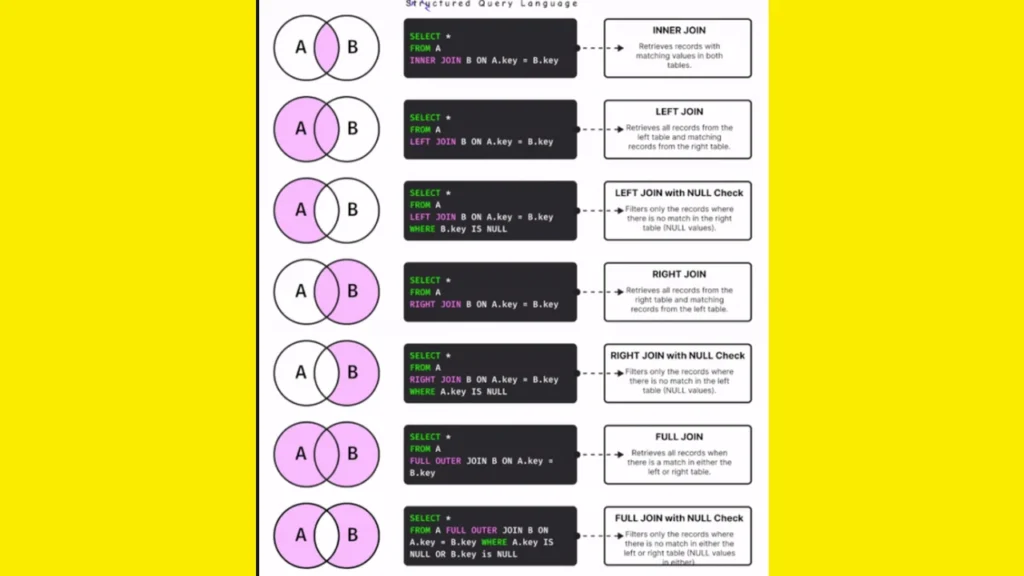In my journey working with databases, mastering SQL joins has been essential for retrieving data from multiple tables effectively. Below is a concise guide to different types of SQL joins, with clear explanations and practical examples. A use case for better understanding accompanies each query.
1. INNER JOIN
Query:
SELECT *
FROM A
INNER JOIN B ON A.key = B.key;
What it does:
Retrieves only the records with matching values in both tables.
Example:
Imagine two tables:
Orders: containsOrderIDandCustomerID.Customers: containsCustomerIDandCustomerName.
To find all orders along with customer names:
SELECT Orders.OrderID, Customers.CustomerName
FROM Orders
INNER JOIN Customers ON Orders.CustomerID = Customers.CustomerID;
2. LEFT JOIN
Query:
SELECT *
FROM A
LEFT JOIN B ON A.key = B.key;
What it does:
Retrieves all records from the left table (A) and the matching ones from the right table (B). If no match, NULL is returned for B’s columns.
Example:
List all customers, including those who haven’t placed any orders:
SELECT Customers.CustomerName, Orders.OrderID
FROM Customers
LEFT JOIN Orders ON Customers.CustomerID = Orders.CustomerID;
3. LEFT JOIN with NULL Check
Query:
SELECT *
FROM A
LEFT JOIN B ON A.key = B.key
WHERE B.key IS NULL;
What it does:
Finds records in the left table (A) that do not have a match in the right table (B).
Example:
Find customers who haven’t placed any orders:
SELECT Customers.CustomerName
FROM Customers
LEFT JOIN Orders ON Customers.CustomerID = Orders.CustomerID
WHERE Orders.OrderID IS NULL;
4. RIGHT JOIN
Query:
SELECT *
FROM A
RIGHT JOIN B ON A.key = B.key;
What it does:
Retrieves all records from the right table (B) and the matching ones from the left table (A). If no match, NULL is returned for A’s columns.
Example:
List all products, including those not yet ordered:
SELECT Products.ProductName, Orders.OrderID
FROM Products
RIGHT JOIN Orders ON Products.ProductID = Orders.ProductID;
5. RIGHT JOIN with NULL Check
Query:
SELECT *
FROM A
RIGHT JOIN B ON A.key = B.key
WHERE A.key IS NULL;
What it does:
Finds records in the right table (B) that do not have a match in the left table (A).
Example:
Identify products that have never been ordered:
SELECT Products.ProductName
FROM Products
RIGHT JOIN Orders ON Products.ProductID = Orders.ProductID
WHERE Orders.OrderID IS NULL;
6. FULL JOIN
Query:
SELECT *
FROM A
FULL OUTER JOIN B ON A.key = B.key;
What it does:
Retrieves all records where there is a match in either table A or B.
Example:
Combine active and archived orders with their details:
SELECT A.OrderID, B.ArchivedOrderDetails
FROM ActiveOrders A
FULL OUTER JOIN ArchivedOrders B ON A.OrderID = B.OrderID;
7. FULL JOIN with NULL Check
Query:
SELECT *
FROM A
FULL OUTER JOIN B ON A.key = B.key
WHERE A.key IS NULL OR B.key IS NULL;
What it does:
Finds records that exist in either table but not in both.
Example:
Find customers who have not placed an order or orders with no customer information:
SELECT Customers.CustomerName, Orders.OrderID
FROM Customers
FULL OUTER JOIN Orders ON Customers.CustomerID = Orders.CustomerID
WHERE Customers.CustomerID IS NULL OR Orders.OrderID IS NULL;
Each of these SQL queries serves a unique purpose in database analysis. By understanding these joins and using the appropriate one for a given scenario, I’ve been able to unlock meaningful insights from relational data.




